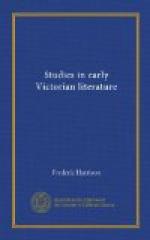Esmond was composed with even greater care than Vanity Fair, and in the matter of style is usually taken to be Thackeray’s greatest masterpiece. Its language is a miracle of art. But it is avowedly a tour de force—an effort to reproduce an entire book in the form and speech of a century and a half preceding. As a tour de force it is wonderful; but in so long a book the effort becomes at last too visible, and undoubtedly it somewhat cramps the freedom of the author’s genius. Thackeray was not a born historical romancist, as were Scott and Dumas; nor was he a born historian at all. And when he undertook to produce an elaborate romance in the form and with the colouring of a past age, like George Eliot, he becomes rather too learned, too conscientious, too rigidly full of his authorities; and if as an historian he enters into rivalry with Macaulay, he somewhat loses his cunning as a novelist. Thackeray’s force lay in the comedy of manners. In the comedy of manners we have nothing but Tom Jones to compare with Vanity Fair. And though Thackeray is not equal to the “prose Homer of human nature,” he wrote an English even finer and more racy.
In Esmond we are constantly pausing to admire the wonderful ingenuity and exquisite grace of the style, studying the language quite apart from the story; and we feel, as we do when we read Milton’s Latin poems or Swinburne’s French sonnets, that it is a surprising imitation of the original. But at the same time Esmond contains some of the noblest passages that Thackeray ever wrote, scenes and chapters which in form have no superior in English literature. That sixth chapter of the second book, in the cathedral, when Henry Esmond returns to his mistress on the 29th of December, on his birthday. “Here she was weeping and happy. She took his hand in both hers; he felt her tears. It was a rapture of reconciliation”—“so for a few moments Esmond’s beloved mistress came to him and blessed him.” To my mind, there is nothing in English fiction which has been set forth in language of such exquisite purity and pathos.




